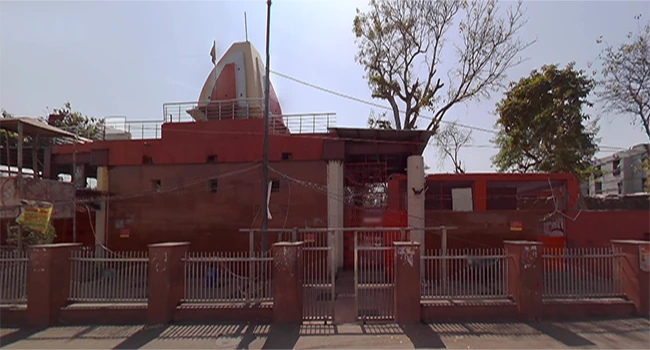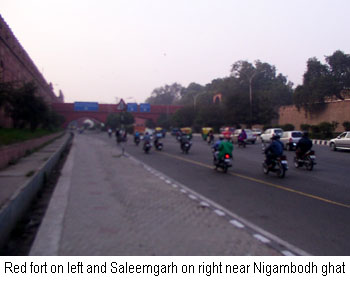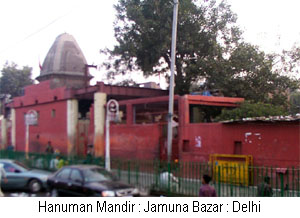
Preface
It was long since I had been to this place and everything seems new for me in this city of Delhi. While at Delhi, I planned to go to Haridwar and hence took a city bus to go to Inter State Bus Stand at Kashmiri Gate. The bus moved on the ring road along the river Yamuna, and I enjoyed the sight of many old monumental structures like Feroze Shah Kotla, Gandhi Memorial Red Fort, etc. On just passing Red Fort, the conductor was calling passengers for Hanuman Sethu to get down. I was wondering at the call since I did not expect a bridge across river Yamuna to be called Hanuman Sethu (thank God! The name was not changed even after the Ram Sethu controversy where even the very name of Sri Rama had been questioned). After a few seconds, the bus passed through a flyover, and I was told that the flyover was named Hanuman Sethu after the famous Hanuman temple nearby. Oh, what a relief! I decided to visit the temple which had given the name 'Hanuman Sethu' to one of the landmarks of Delhi. On my return, I visited the temple on the banks of the river Yamuna near Nigambodh Ghat.
City of Gods - Indraprastha
Present Delhi was known as the city of Gods - Indraprastha, raised by Pandavas on the banks of Yamuna sister of Yama, king of death. The city of Indraprastha was one of the bones of contention between two houses of cousins, the Kauravas and the Pandavas. Nothing remains of Indraprastha above ground now. However recent excavations at the Old Fort have revealed fine gray earthenware that could support the theory of the existence of Indraprastha at that site.
Though it is customary to say there are eight Delhis, presently only two are known namely Old Delhi and New Delhi. While Old Delhi denotes Shahjahanabad built by Shahjahan with a majestic red fort as the heart of it, the British with the present Rastrapati Bhavan as the heart of it built New Delhi. But this place even dates back to Mahabaratha or even to the Vedic period.
Shajahanabad alias Old Delhi
Shahjahanabad, the 17th-century city of Shah Jahan and the seventh city of Delhi was completed in 1649. And was built like a huge fortress surrounded by strong rubble-built high walls from all sides with bastions, 14 high-arched openings gates, and 16 windows.
The old city Shajahanabad had been well planned and had fourteen arched gates through which one could enter the city, in the sense the city itself was fortified. Most of the gates to the city had been named after the direction to which city they would lead one out. For example, the north had Kashmiri Gate, the west had Delhi Gate, and the northwest had Ajmeri Gate, etc. Shahjahanabad had the Red Fort as its base or the central theme of the city. River Yamuna was the eastern boundary of Red Fort, as well as the old city of Delhi.
Nigambodh Gate and Ghat
 It is worth mentioning here that there was a small fort named Saleemgarh Fort on the island formed by
the off shot of Yamuna and the main course of the river Yamuna. It was the northeastern corner of the
city. The gate at this point is known as the Nigambodh Gate. As per the practice of naming the gates
after the place to which it will lead this gate had been named Nigambodh Gate since it leads to
Nigambodh. The stretch of land along the river Yamuna known as Nigamboth dates back to the days of the
Mahabharata and the Hindu period. The original ghat (river bank from where people can take a
bath in the river) extended towards the gate and near the Saleemgarh fort.
It is worth mentioning here that there was a small fort named Saleemgarh Fort on the island formed by
the off shot of Yamuna and the main course of the river Yamuna. It was the northeastern corner of the
city. The gate at this point is known as the Nigambodh Gate. As per the practice of naming the gates
after the place to which it will lead this gate had been named Nigambodh Gate since it leads to
Nigambodh. The stretch of land along the river Yamuna known as Nigamboth dates back to the days of the
Mahabharata and the Hindu period. The original ghat (river bank from where people can take a
bath in the river) extended towards the gate and near the Saleemgarh fort.
The name Nigambodh
It is interesting to know how this place got the name Nigambodh Ghat. According to legends, Brahma once lost His memory and also His palm leaf scripts. On counseling with Wise, it came to be known that He has to take a dip in the river Yamuna in Indraprastha. Accordingly, He took a plunge into the river Yamuna to recover His lost memory and also discovered where he had kept his sacred books. The name Nigambodh is derived from Nigam signifying the Ved and Bodak the knowledge.
Yamuna Bazzar
Presently one can see remains of the Saleemgarh - an old structure modified and constructed by the Britishers for their regimental needs. Still, the arches right on the ring road in the island formed by the ring road and Bela road will remind one of Saleemgarh. The bridge connecting the Red Fort and Saleemgarh is seen over the ring road. The river Yamuna had changed its course and drifted eastward, thereby shifting the Nigambodh ghat eastward and the off shot of Yamuna is no more there. The Nigambodh ghat is now known for the crematorium it houses. Less known is the Neel Chatri mandir dedicated to Lord Shiva said to have been built by Yudhistra the eldest of Pandavas. Ring Road had come up in a place where Yamuna and its offshoot were once flowing. But on one side of the ring road is present-day Yamuna Bazar, which was once part of Nigambodh ghat before Yamuna changed its course.
The ancient temple for Lord Anjaneya known as Lord Hanuman in Yamuna Bazar, had been re-established by Sant Sri Markata Babaji during the Mughal time. Presently this temple is popular as 'Yanuman Bazar Hanuman Mandir - Markata babaji wale'.
Temple of Anjaneya alias Hanuman
There is an ancient temple for Lord Anjaneya known as Lord Hanuman here in Yamuna Bazar. The temple had been re-established by Sri Markata Babaji during the Mughal time. Presently this temple is popular as 'Yanuman Bazzar Hanuman Mandir - Markata babaji wale'. There are many versions that describe the coming up of the Sri Hanuman temple at this place. Before we go to the narration of those versions of the legend, let us visit the temple first. The temple entrance is east-facing. As one enters the temple he comes across a big open space with a lot of small mandaps built by various donors at different times. Hanumath devotees sit in groups in those mandaps and chant the glory of Sri Hanuman. Most of them chant Sri Hanuman Chalisa or Sri Hanuman Bahook. There are renovations taking place in these mandaps. The main temple is on the left side as one enters the temple complex. There is a long queue to have the darshan of the Lord in the main temple.
Lord Anjaneya alias Hanuman
The main temple is west facing and the Lord Hanuman is also seen facing west. The main moorthi of the Lord is seen installed at around fifteen feet depth. It is said over a period of time the ground level had been increased along the ring road, with the development of the city. But the idol of the Lord Hanuman is said to be where it was originally installed. The moorthi is around three to four feet and the Lord Hanuman is seen as embossed in the stone and had been covered with senturam i.e., vermillion paste. There is water around the Lord and it will be seen as if the Lord is standing in the water. Lord of this kshetra is seen holding the Sanjeevi parvatham in His right hand, and the left hand is seen as if touching the ground.
The legend of the kshetra
 It is very difficult to know how old the temple is. The first legend marks it as around the end of the
Kritha yuga and the beginning of the tratha yuga, when it is stated that Sri Brahma had
lost the memory and also the scripts of Veda. On the advice of wise and devas, Sri Brahma had
come down to take a dip in the holy Yamuna here in this spot. On taking a dip at this spot in the
river, he regained the memory and also got back the lost script. Thereby this river bank got the name
Nigambodh Ghat. Hanumanji had learned all Vedas and other arts from none other than Lord
Surya himself. He had done this without disturbing the routine of the Lord Surya, by moving backwardly
and facing His master. In the process, Hanumanji came to know the story of the loss of scripts by Sri
Brahma. In His inquestness to know that no script is left behind at Nigambodh, the Lord had come here
and was searching. Hence the posture of Hanumanji of this kshetra is seen as if He is searching
the banks of the river Yamuna.
It is very difficult to know how old the temple is. The first legend marks it as around the end of the
Kritha yuga and the beginning of the tratha yuga, when it is stated that Sri Brahma had
lost the memory and also the scripts of Veda. On the advice of wise and devas, Sri Brahma had
come down to take a dip in the holy Yamuna here in this spot. On taking a dip at this spot in the
river, he regained the memory and also got back the lost script. Thereby this river bank got the name
Nigambodh Ghat. Hanumanji had learned all Vedas and other arts from none other than Lord
Surya himself. He had done this without disturbing the routine of the Lord Surya, by moving backwardly
and facing His master. In the process, Hanumanji came to know the story of the loss of scripts by Sri
Brahma. In His inquestness to know that no script is left behind at Nigambodh, the Lord had come here
and was searching. Hence the posture of Hanumanji of this kshetra is seen as if He is searching
the banks of the river Yamuna.
The second legend marks it around the Ramayana period. After Sri Ram's coronation and happy living in
Ayodhya, Sri Rama sends Sri Sita Devi into exile on account of one of the citizens doubting the
character of Devi [
These are the two legends among the many variations in the legends narrated.
The temple and around
The temple is very well kept up, neat, and tidy. A well-maintained garden just behind the temple known as Hanuman Vatika is used for discourses on Tulasi Das's Ramachand Manas, Valmiki's Ramayan, and Hanuman Chalisa.
Location of the temple: "Markata Baba Sri Hanuman Mandir, Yamuna Bazzar, Delhi"
Experience
Sri Hanumanji of this temple at Yamuna Bazar, Nigambodh Ghat bestows knowledge, discipline, and courage to face the world to the devotees.
SRI HANUMAN THINKS DIFFERENTLY, THINKS FAST
THINKS AHEAD AND ACTS FOR SURE
Ed [March 2009]
Updates: [Jan 2025]
